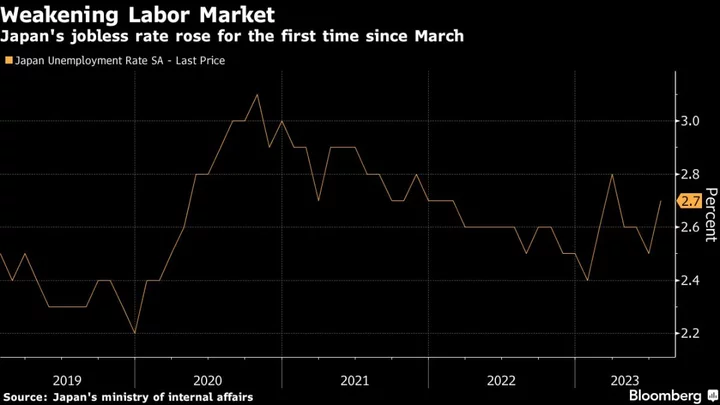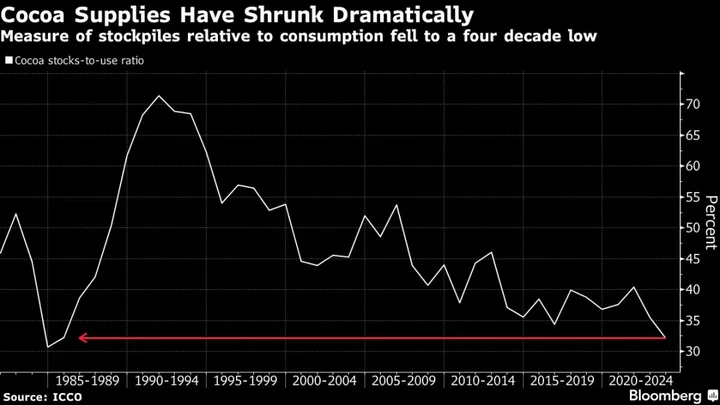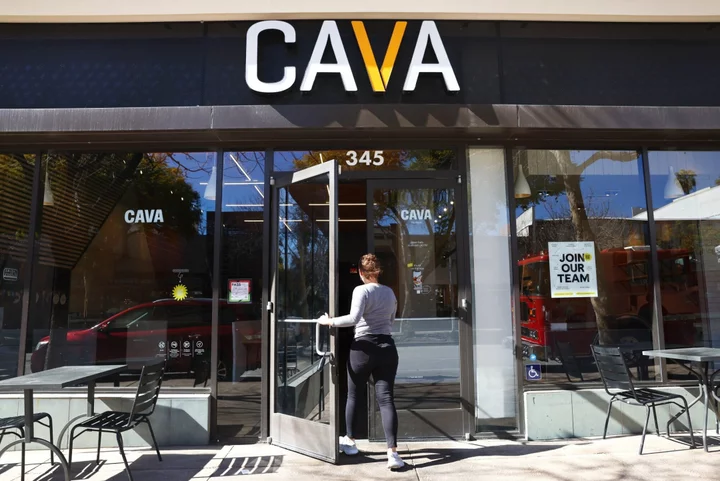T. Rowe Price Group Inc. is reeling from a $127 billion exodus over just two years. At Franklin Resources Inc., the latest member of a billionaire family to run the firm is trying to reverse a nearly uninterrupted 20-quarter losing streak. Across the Atlantic, the chief of Abrdn Plc has reached a blunt conclusion: merely managing mutual funds isn’t enough of a business any more.
Across the $100 trillion asset-management industry, money managers have confronted a tectonic shift in investor appetite for cheaper, passive strategies over the past decade. Now they’re facing something even more dire: The unprecedented run of bull markets that buoyed their investments and masked life-threatening vulnerabilities may be a thing of the past.
About 90% of additional revenue taken in by money managers since 2006 is simply from rising markets, and not from any ability to attract new client money, according to Boston Consulting Group. Many senior executives and consultants now warn that it won’t take much to turn the industry's slow decline into a cliff-edge moment: One more bear market, and many of these firms will find themselves beyond repair.
“It’s a final act in that many firms that have coasted for decades will no longer be able to coast,” said Ben Phillips, head of the asset-management global advisory business at Broadridge Financial Solutions Inc. “These firms have to change, and they have to pull it off.”
More than $600 billion of client cash has headed for the exits since 2018 from investment funds at T. Rowe, Franklin, Abrdn, Janus Henderson Group Plc and Invesco Ltd. That’s more than all the money overseen by Abrdn, one of the UK’s largest standalone asset managers. Take these five firms as a proxy for the vast middle of the industry, which, after hemorrhaging client cash for the past decade, is trying to justify itself in a world that’s no longer buying what it’s selling.
The reasons for the companies’ struggles aren’t a secret: Investors are ditching mutual funds for much cheaper passive strategies, largely managed by giants BlackRock Inc., Vanguard Group Inc. and State Street Corp., causing a dramatic, industrywide fee compression that’s put a strain on the revenue and margins of smaller players.
And with geopolitical tensions and higher interest rates becoming the status quo, even the $9.1 trillion behemoth BlackRock is feeling some of the pain. In the three months through September, clients pulled a net $13 billion from its long-term investment funds, the first such outflows since the onset of the pandemic in 2020.
“Structural and secular changes in business models, technology and, most of all, monetary and fiscal policy have made the last two years extremely challenging for traditional asset management,” BlackRock Chief Executive Officer Larry Fink told analysts this month.
Bloomberg News analyzed more than five years of money flows, fees, investment performance, revenue and profit margins at the five firms, as well as trends across the industry, to show how the active managers are at greater risk than ever before. The five publicly traded firms — which oversaw more than $5 trillion as of June 30 for everyone from workers with 401(k) plans to the biggest pension funds in the world, and have all been household names in global asset management for decades — were chosen as a representation for asset management’s middle tier, which is now facing immense pressure, with their struggles shared by most other players in the sector.
The shares of all five firms hint at the state of play. Except for T. Rowe Price, all of the companies have lost at least a third of their value since the beginning of 2018, compared with an increase of about 60% for the S&P 500. Except for Abrdn, which reports results every six months, the firms are set to report quarterly earnings over the next two weeks, starting Tuesday with Invesco.
Despite their hope that clients will return to stock and bond pickers when the going gets tough — and pay for it — the downward trajectory seems irreversible. Passive products have been gaining so much traction, regardless of whether markets go up or down, that by midyear they accounted for half of all assets in US mutual funds and ETFs, up from 47% in 2022 and 44% in 2021, according to data compiled by Bloomberg from asset managers. A decade ago, it was just 27%.
As if fighting the index machines wasn’t enough, there’s now a new enemy to contend with: cash, which is where investors want to keep their money while interest rates remain high.
The previous generation of CEOs made myriad attempts to turn things around: They slashed fees (resulting only in lower revenue), they merged with rivals (creating more problems than they solved), they jumped on various bandwagons, such as ESG, hoping to give themselves an edge (and ended up looking more like their competitors than different from them). Nothing worked.
Now it falls to a new crop of bosses across active management — including Rob Sharps at T. Rowe, Andrew Schlossberg at Invesco, Ali Dibadj at Janus, Stephen Bird at Abrdn and Jenny Johnson at Franklin — to turn things around. The new chief executive officers, a mix of company veterans and outsiders hired to shake things up, are reckoning with sprawling legacy businesses that seem to contract by the month and the increasingly urgent need to expand beyond their core focus of old-fashioned, actively managed mutual funds.
“Over the last 10 years, more than 100% of revenue increase was market-performance driven — just markets going up,” said Stefan Hoops, CEO of DWS, the $900 billion asset-management arm of Deutsche Bank AG, who took over last year and has been throwing cash into ETFs and alternatives to deal with the pressure. “Now imagine you have markets going sideways, but the same quantum of margin compression, then all of a sudden you’re potentially faced with a decade of shrinking revenues.”
Franklin has had only two quarters of net long-term inflows since 2018, even in buoyant markets and after acquisitions. Janus Henderson had its first quarter of inflows earlier this year after 21 consecutive quarters of outflows, only to start bleeding again. Abrdn hasn’t seen a year of net inflows since it was created via a merger in 2017. Tens of billions of dollars have left T. Rowe’s funds since mid-2021, and its management-fee revenue dropped by more than 15%. And Invesco has seen almost no revenue growth in three years.
Read more: QQQ Makes Invesco No Money, So It Created a Family of Baby ‘Qs’
BlackRock, meanwhile, which dominates the asset-management industry globally, has nearly twice the assets of all five firms combined, and its net flows to long-term investment funds totaled $1.7 trillion from the beginning of 2018 through midyear.
“The middle players can’t grow organically out of this scenario,” said Evan Skalski, an associate director at Alpha FMC, which consults the top 20 global asset managers. “They can try to manage the costs and keep the current business running, but they’re going to have to be OK with a low-growth or no-growth story.”
Here’s one example of how hard it is to keep money in the house: Janus Henderson’s Research Fund. It was set up in 1993 with the goal of investing in the best ideas produced from across the London-based company, which has US roots in the 1990s tech-stock boom. With $17 billion in assets, it’s the firm’s third-largest US fund. But it underperformed the Russell 1000 Growth index each calendar year for eight years, according to Morningstar Inc. and the company’s website.
In an emailed statement, a Janus Henderson spokesperson acknowledged the challenges and said that executives changed the fund’s portfolio early last year with the goal of improving performance. It has outperformed the benchmark in the 12 months through October 16, the spokesperson said.
Speaking to Bloomberg News from a Janus Henderson client conference in Madrid in late September, CEO Dibadj conceded that many of the industry’s problems stem from its inward-looking nature.
“Historically this industry would create new products in a vacuum without thinking of the actual need of the client,” he said. Dibadj said he’s been in frustrating meetings where customers weren’t even aware of what the firm has available. “That’s surprising and bothersome to me.”
The situation is similar at the other firms. Franklin’s 75-year-old Income Fund, for example, has about $69 billion in total assets but has had net outflows of about $19 billion in five years, according to Morningstar. Its Western Asset Core Plus Bond Fund, with about $21 billion in total assets, has had redemptions of more than $10 billion just since the start of 2022. T. Rowe’s $27 billion Mid-Cap Growth Fund and $50 billion Blue Chip Growth Fund have had billions of dollars in outflows and asset declines since the beginning of 2022.
Invesco and Franklin declined to comment for this story or make their CEOs available for interviews. T. Rowe acknowledged the challenges in a statement, said it expects flows to equity and bond strategies to increase in the future and is working to offer a broader range of products. T. Rowe’s CEO declined to be interviewed for this story.
Abrdn’s Bird has largely abandoned competing in large-cap equity funds, choosing instead to emphasize small-cap and emerging-market strategies. He’s cut the business into three parts: a mutual fund business, a wealth unit that also serves retail investors and a platform for financial advisers — a strategy that has yet to prove it’s working.
“If you don’t change the model of your business, the fee compression and overcapacity in asset management is going to take you out,” Bird, a former Citigroup Inc. executive who took the helm at Abrdn two years ago, said in an interview. Exchange-traded funds have changed the business, he said. “There’s no debate: the machine won. You need businesses that are not just in pure active asset management.”
For many other firms, private markets — and, specifically, the private-credit craze — are now the latest perceived savior. Almost everyone, from small to giant stock-and-bond houses, is piling into the asset class, often for the first time. In the past year and a half, a surge in M&A in the space has been driven by such houses, including Franklin, that are eager to offer clients the increasingly popular strategies, which typically charge higher fees. Others have been poaching teams or announcing plans to enter the space.
Read more: Fund Giants Muscle In on the $1.5 Trillion Private Credit Party
“I think that’s a big driver for many of these firms — they look at their own financials and think about what’s going to keep us afloat over the next few years,” Amanda Nelson, principal at Casey Quirk asset-management consultancy at Deloitte, said in an interview.
To many consultants and industry executives, this latest attempt to stay in the game — and save ever-squeezed margins — may juice revenues in the short term but won’t be the Hail Mary they’re looking for.
For example, T. Rowe Price’s purchase of Oak Hill Advisors for up to $4.2 billion — announced with much fanfare in 2021 — cost a lot, but has done little to change the firm’s fortunes so far.
“It’s been 18 months — we closed right at the end of 2021. Overall, I think it has gone very well,” Sharps said in an interview this summer. “But in being balanced and transparent, I would say the capital-raising environment is more challenging, and their results are consistent with that.”
The firm launched a private credit fund this month with $1.5 billion, partly seeded with money from T. Rowe, which manages $1.4 trillion in total assets.
Franklin’s Johnson has also paid billions to go on a deal spree in the past three years, picking up firms including Lexington Partners, for $1.75 billion. Franklin now says it manages $257 billion in alternative assets, roughly 18% of the firm’s overall business. The acquisitions have increased assets under management and, as a result, revenue, but haven’t fully reversed years of overall net outflows and tightening of adjusted operating margins by almost 14 percentage points between 2018 and the end of last year.
All the changes being made across the dozens of firms in the middle tier of the industry — acquisitions, breaking into asset classes, cutting fees — may do little but delay the inevitable.
“It’s a slow but surely declining trajectory,” said Markus Habbel, head of Bain & Co.’s global wealth- and asset-management practice. “There is a scenario for many of these players to survive for a few years while their assets and revenues decline until they die. This is the trend in the majority of the industry.”
--With assistance from Yue Qiu, Christopher Cannon and Mathieu Benhamou.









